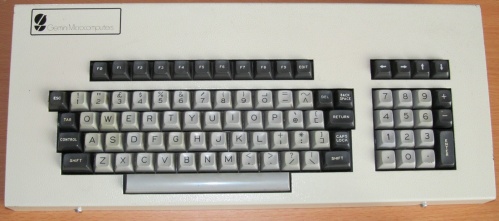
This was the “big brother” of Gemini’s steel-cased keyboards. Once again, it was a 7-bit ASCII design like the GM821 (which it later replaced), with the character read on the positive side of the strobe. Although they are similar in some ways, these two keyboards are in fact quite different in others. The GM821 was built by Cherry, this was built by Rotec.

Once again, a steel frame is used for the keys but this seems to me to be a little more substantial. The Function keys, cursor keys & numeric pad send codes to the video card which allows them to be programmable (in both normal & shifted modes), allowing up to 59 programmable keys! (The EDIT key didn’t behave as a function key when un-shifted). Note that the programming is not contained within the keyboard so it is lost when the system is switched off. However, a CP/M program allows the function key programs to be saved to & loaded from disk.
If you were rich enough to order one of these 36 years ago in 1982 it would have cost you £85.00 for the bare keyboard. The steel case was an extra £25.00! That was serious money for a keyboard.

For some reason there is a small interface board mounted on the rear. My guess is that this is the character generator but it is only a guess. The EPROM is a 2516 2k x 8 device.
The keys on this keyboard are capacitive. The PCB has 2 pads separated by a gap. The pads are then covered by a thick lacquer. The key presses a metal disc down across the pads to make a capacitive connection, the lacquer insulating them from an electrical one. Scanning pulses on one pad are thus passed through to the other pad while the key is pressed. Some early versions of this keyboard appear to have had a problem with small particles of dirt getting under the metal disk, preventing it from descending fully. This caused reliability problems in some cases.
This is one of Gemini’s double-byte keyboards. Links on the SVC card allow the system to be switched between single (GM821) and double byte (GM827, GM852P) keyboards. The double-byte system is necessary to get the extra codes to handle the function keys.
All the additional keys send 1BH (Esc) then key code. Esc itself was redefined as 1B 00. The function keys continued from there, F1=1B 01, F2=1B 02, F3=1B 03 etc.

0 Responses to “GM827 87-key Parallel Keyboard”